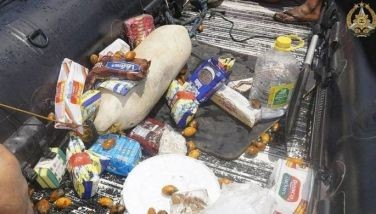Washing of the Feet rite isn't a kind of 'Holy Spa'

RITE REVISIONS: Some of the more imaginative matrons in the parish refer to the Washing of the Feet in today’s Lenten rites as “Holy Spa.” No irreverence meant, I am sure, but it just goes to show that there has been an evolving of attitudes in the externals of our religion.
In Melbourne, Australia, a parishioner asked if it was all right for the part of the traditional 12 men representing the apostles in the Washing of the Feet rites to now be played, in the spirit of gender equality, by six gentlemen and six ladies.
While Mary Magdalene reportedly washed and massaged Jesus’ feet — one account I read said she did it with oil and used her luxuriant hair to dry his feet — some present-day priests may not be comfortable washing and maybe kissing the feet of a woman in public.
I don’t know really, I’m not a priest yet.
Some men, not necessarily inebriated, even want to know if it is permissible for the priest to wash other parts of the body aside from the feet. You know how Filipinos love to adopt things they like and proceed to reconfigure them.
* * *
LADIES, TOO?: What revisions if any, have been introduced or tolerated in the centuries-old Lenten rites of the Church? We wish our bishops clarified if certain deviations have been allowed for the faithful in the Philippines.
To answer some of the questions raised above, we turn to Fr. Edward McNamara, professor of liturgy at the Regina Apostolorum Pontifical Athenaeum. His comments have been featured by the Vatican-based Zenit.org news service.
On whether or not women may represent the 12 apostles in the Washing of the Feet rite, McNamara said:
“The rubrics for Holy Thursday clearly state that the priest washes the feet of men (‘viri’) in order to recall Christ’s action toward his apostles. Any modification of this rite would require permission from the Holy See.
“It is certainly true that in Christ there is neither male nor female and that all disciples are equal before the Lord. But this reality need not be expressed in every rite, especially one that is so tied up to the concrete historical circumstances of the Last Supper.”
* * *
AN EXCEPTION: Elsewhere earlier, McNamara noted that in 2005, “the Holy See, while affirming that the men-only rule remains the norm, did permit a US bishop to also wash women’s feet if he considered it pastorally necessary in specific cases.
“This permission was for a particular case and from a strictly legal point of view has no value outside the diocese in question.
“(On when to perform it), depending on pastoral circumstances, the washing of feet may follow the homily.
“The men who have been chosen are led by the ministers to chairs prepared in a suitable place. Then the priest (removing his chasuble if necessary) goes to each man. With the help of the ministers he pours water over each one’s feet and dries them.
“The number of men selected for the rite is not fixed. Twelve is the most common option, but they may be fewer in order to adjust to the available space.”
* * *
CREAKING BONES: As to another question asking if an older or arthritic priest who has difficulty stooping, or if able to kneel down is unable to rise again easily, may omit the Washing rite or delegate it to somebody else, McNamara said:
“The rite of the Washing of Feet is not obligatory and may be legitimately omitted. However, this is usually not pastorally advisable.
“While the rite may not be delegated to a non-priest, a concelebrant may substitute the main celebrant for a good reason.
“The rubrics describing this rite are limited to the essentials (selected men sit in a suitable place) and so allow for practical adaptations to the realities of place, time and circumstances.
“Thus, taking the example of our Holy Father, as he has grown older, and less able to bend over, the seats of those whose feet he washed were first elevated so that he could continue to perform the rite. But in the last year or so he has been substituted by a cardinal.
“I do not think it is contrary to the overall sense of the rite to find other practical solutions resulting in a similar effect, provided the rite is carried out with decorum.”
* * *
DONATE, SUBSCRIBE: Readers who can spare $25, or more, are encouraged to donate to Zenit.org and help in its global information apostolate.
A good variation is to buy a subscription for somebody you want to grow in faith or for a friend or a media personality who you want to learn more about the Church and possibly transform him into an active bearer of the Good News. The varied and authoritative menu offering of Zenit suits the needs and interests of Filipino subscribers.
Some 3,300 English-edition subscribers were gathered by Zenit in its last annual fund-raising campaign. Among the beneficiaries are missionaries who are giving their lives for the Gospel but cannot afford to pay for a subscription.
Donations are tax deductible in the United States, Mexico, Spain, France and Germany. For more information, those interested may go to: [email protected].
* * *
FOLLOWUP: Access all POSTSCRIPTs at www.manilamail.com. Follow us at Twitter.com/@FDPascual. Email to [email protected]m
- Latest
- Trending



























